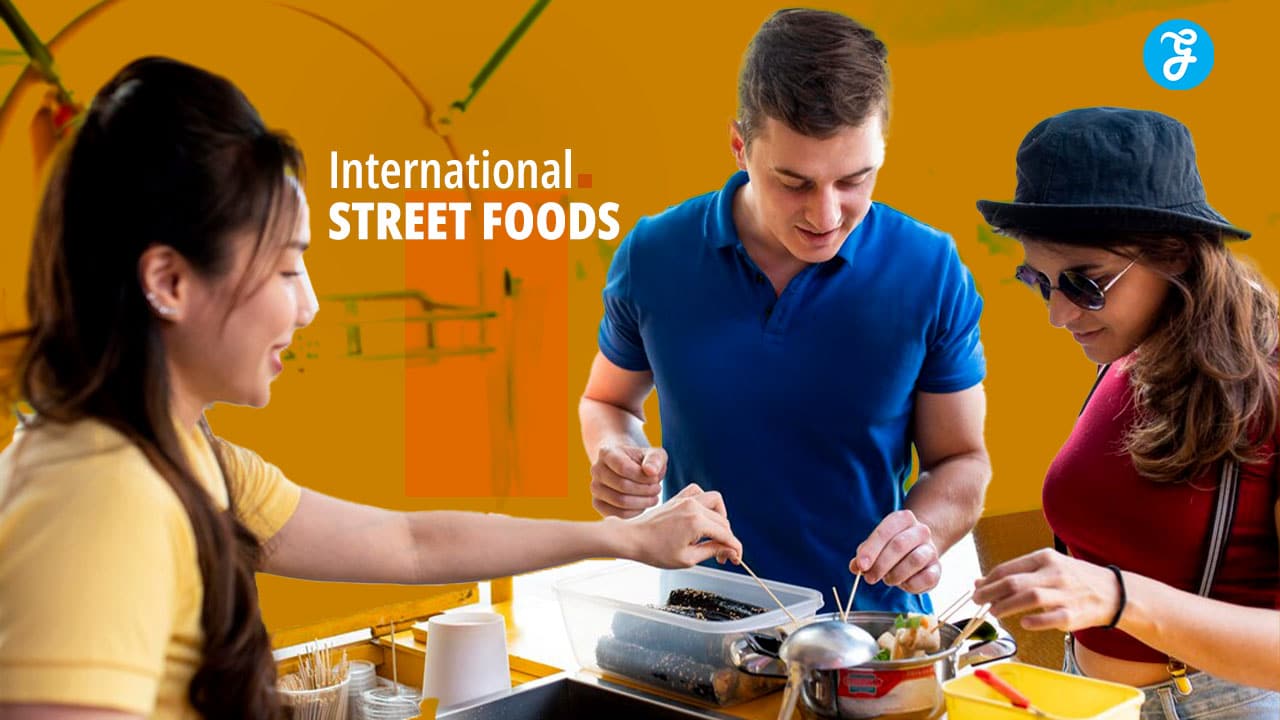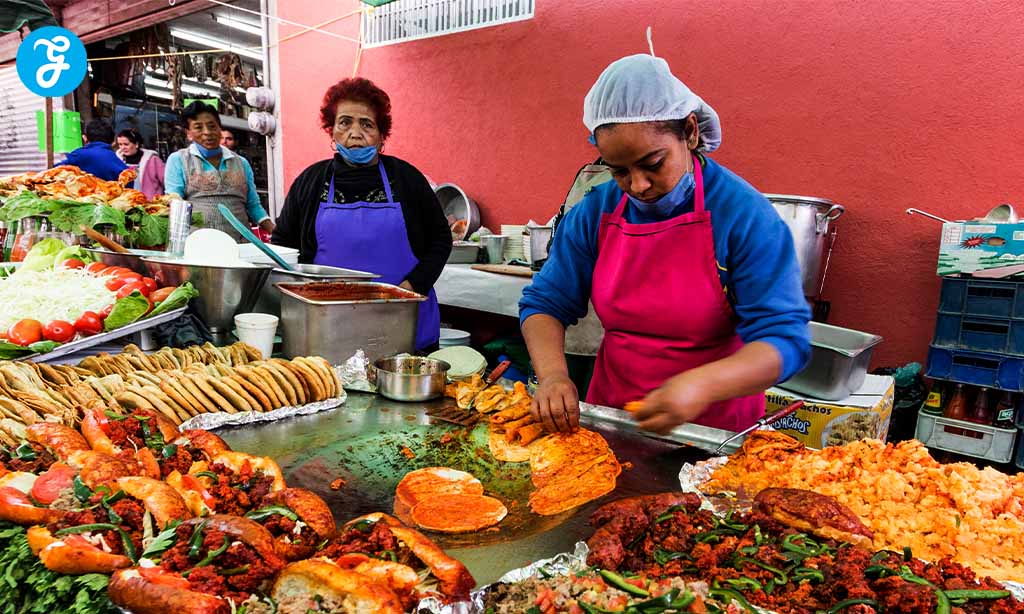Street food is the heart and soul of culinary exploration. It’s where authenticity meets affordability and where local flavours shine brightest. From the bustling markets of Southeast Asia to the cobblestone streets of Europe, street food offers a window into a culture’s tastes, traditions, and daily life.
This article takes you on a mouthwatering journey worldwide, introducing you to 12 must-try international street foods. These dishes aren’t just delicious; they’re cultural experiences served on a plate (often in a paper wrapper).
So, put on your imaginary walking shoes, bring your appetite, and explore the vibrant world of global street cuisine!
1. Tacos al Pastor (Mexico)
Our culinary journey begins in Mexico with tacos al pastor, a dish that perfectly encapsulates the country’s rich culinary heritage and cultural fusion.
Origin and History
Tacos al pastor, which translates to “shepherd-style tacos,” has a fascinating origin story that reflects Mexico’s diverse cultural influences. This dish is a result of Lebanese immigration to Mexico in the early 20th century.
The immigrants brought the tradition of shawarma – meat cooked on a vertical spit. This cooking method was adapted by Mexican cooks, who replaced the traditional lamb with pork and added local spices and flavours.
Ingredients and Preparation
The star of tacos al pastor is marinated pork, typically shoulder or leg cuts. The marinade is a complex blend of spices and chillies, often including:
- Achiote paste (made from ground annatto seeds)
- Guajillo chillies
- Garlic
- Cumin
- Oregano
- Vinegar
- Pineapple juice
The marinated pork is stacked in layers on a vertical spit called a “trompo,” which means “spinning top” in Spanish. A piece of pineapple is usually placed on top of the meat stack. As the meat cooks, it’s slowly rotated, allowing the fat to baste it and create a crispy exterior.
To serve, thin slices of the caramelised pork are shaved off the spit directly onto small corn tortillas. The tacos are typically garnished with:
- Diced onions
- Fresh cilantro
- A slice of the roasted pineapple
- Lime wedges
- Salsa (often a spicy red salsa or a milder green salsa)
Cultural Significance
Tacos al pastor is more than just a popular street food; they symbolise Mexico’s culinary fusion and adaptability. This dish represents blending Middle Eastern cooking techniques with Mexican ingredients and flavours, resulting in something uniquely Mexican.
In Mexico City and many other parts of the country, tacos al pastor are a late-night staple. After a night out, it’s common to see people gathering at taco stands, enjoying this flavorful dish.
The communal aspect of eating at these stands, often standing shoulder to shoulder with strangers, is an integral part of Mexican urban culture.
Nutritional Information
While delicious, tacos al pastor are typically high in calories and fat due to the fatty cuts of pork used. However, they also provide a good amount of protein. Here’s a rough nutritional breakdown for a typical taco al pastor:
- Calories: 170-200 per taco
- Protein: 10-15g
- Fat: 8-12g
- Carbohydrates: 15-20g
The addition of pineapple provides some vitamin C, while the corn tortilla offers some fibre. The fresh toppings like cilantro and onions add small amounts of vitamins and minerals.
Where to Find the Best Tacos al Pastor?
If you’re in Mexico City, some of the most renowned spots for tacos al pastor include:
- El Huequito: A local institution since 1959, known for its crispy, flavorful pastor.
- El Vilsito: It’s an auto repair shop by day. It transforms into one of the city’s best taco stands by night.
- Los Güeros: Famous for its extra-large portions and perfectly caramelised meat.
Remember, part of the experience is in the atmosphere. Look for busy stands with a crowd of locals – that’s often a sign of quality!
2. Bánh Mì (Vietnam)
From Mexico, we travel halfway across the world to Vietnam, where we encounter the beloved bánh mì, a sandwich that tells the story of Vietnam’s colonial past and culinary innovation.
Origin and History
Bánh mì is a perfect example of fusion cuisine, born from the intersection of Vietnamese and French cultures during France’s colonial rule of Vietnam (1887-1954). The term “bánh mì” actually refers to bread in Vietnamese, but it has come to represent this specific type of sandwich.
The sandwich began as a French baguette with cold cuts and pâté, mirroring French cuisine. However, after Vietnam gained independence, local cooks began to add Vietnamese flavours and ingredients, transforming it into the unique dish we know today.
Ingredients and Preparation
A traditional bánh mì consists of:
- Bread: A Vietnamese-style baguette, lighter and crispier than its French counterpart due to adding rice flour.
- Protein: This can vary, but standard options include:
- Grilled pork (thịt nướng)
- Vietnamese cold cuts
- Pâté
- Tofu for vegetarian versions
- Vegetables:
- Pickled daikon radish and carrots
- Fresh cucumber slices
- Cilantro sprigs
- Jalapeño or bird’s eye chilli slices
- Condiments:
- Mayonnaise (often homemade)
- Maggi seasoning sauce
- Sometimes butter or cheese, a remnant of French influence
The preparation involves slicing the baguette lengthwise, spreading it with pâté and mayonnaise, and then layering the protein and vegetables. The sandwich is often slightly warmed before serving to crisp up the bread.
Cultural Significance
Bánh mì is more than just a sandwich; it symbolises Vietnam’s resilience and creativity. It represents how Vietnamese people took a foreign concept (the French baguette sandwich) and made it uniquely by incorporating local flavours and ingredients.
In Vietnam, bánh mì is ubiquitous. It’s eaten for breakfast, lunch, or as a quick snack. Street vendors selling bánh mì from carts or small stalls are a common sight in Vietnamese cities, and the sandwich has become famous worldwide as Vietnamese cuisine has spread globally.
Nutritional Information
Unlike many other street foods, Bánh mì can be a relatively balanced meal. Here’s an approximate nutritional breakdown for a typical bánh mì:
- Calories: 350-450
- Protein: 15-20g
- Fat: 12-18g
- Carbohydrates: 40-50g
The vegetables provide fibre and vitamins, while the protein source offers satiety. However, the nutritional content can vary significantly depending on the ingredients used.
Where to Find the Best Bánh Mì?
If you’re in Vietnam, some renowned spots for bánh mì include:
- Bánh Mì Phượng in Hoi An: Made famous by Anthony Bourdain, this spot is known for its variety of fillings.
- Bánh Mì Huỳnh Hoa in Ho Chi Minh City: Often considered the best in the city, with generous portions of meat.
- Bánh Mì 25 in Hanoi: A popular spot among locals and tourists, known for its crispy bread and flavorful fillings.
Remember, some of the best bánh mì can be found at humble street carts. Don’t be afraid to try a sandwich from a vendor with a long line of locals!
3. Currywurst (Germany)
Our next stop takes us to Germany, where we encounter currywurst, a street food that has become a cultural icon in Berlin and beyond.
Origin and History
Currywurst is a relatively recent addition to the world of street food, with a history that dates back to post-World War II Germany. The dish was invented in 1949 by Herta Heuwer, a food kiosk owner in Berlin.
Legend has it that Heuwer obtained ketchup, Worcestershire sauce, and curry powder from British soldiers, and she experimented with these ingredients to create a sauce for traditional German sausages. The result was an instant hit with construction workers rebuilding the war-torn city, and currywurst quickly became a Berlin staple.
Ingredients and Preparation
Currywurst consists of two main components:
- Sausage: A steamed then fried pork sausage (bratwurst) is typically used. In some variations, the sausage is sliced before serving.
- Curry Sauce: This is what makes currywurst unique. The sauce is typically made from:
- Tomato ketchup or tomato paste
- Worcestershire sauce
- Curry powder
- Other spices (which vary by recipe and are often closely guarded secrets)
The dish is prepared by:
- Frying or grilling the sausage
- Slicing it (optional)
- Dousing it in the warm curry sauce
- Sprinkling additional curry powder on top
Currywurst is usually served with french fries or a bread roll. It’s often served on a paper plate with a small wooden or plastic fork in Berlin.
Cultural Significance
Currywurst has transcended its humble origins to become a true cultural phenomenon in Germany, particularly in Berlin. It’s more than just fast food; it’s a part of the city’s identity. The dish crosses all social boundaries – it’s enjoyed by construction workers and businesspeople alike.
The importance of currywurst in German culture is evidenced by the Deutsches Currywurst Museum in Berlin (which operated from 2009 to 2018), which is dedicated entirely to this street food. The museum showcased the history of currywurst and its place in German popular culture.
Currywurst is also featured in German popular media, including films and literature. It’s often used as a symbol of Berlin or German street food culture.
Nutritional Information
Currywurst is a high-calorie, indulgent dish. Here’s an approximate nutritional breakdown for a typical serving of currywurst with fries:
- Calories: 800-1000
- Protein: 25-30g
- Fat: 55-65g
- Carbohydrates: 60-70g
The dish is high in fat and sodium, and the curry sauce often contains added sugars. However, it does provide a good amount of protein.
Where to Find the Best Currywurst?
If you’re in Berlin, some famous spots for currywurst include:
- Konnopke’s Imbiss: One of the oldest and most famous currywurst stands in Berlin, operating since 1930.
- Curry 36: A popular chain known for its crispy fries and perfectly balanced curry sauce.
- Curry Baude: A local favourite, a small stand known for its homemade sauce.
In other parts of Germany, look for busy street stands or small restaurants specialising in currywurst. The dish is trendy in the Ruhr area and Berlin.
4. Jianbing (China)
Our culinary journey now takes us to China, where we discover jianbing, a popular breakfast street food that has satisfied hungry commuters for centuries.
Origin and History
Jianbing, often described as a Chinese crepe or pancake, has a history that dates back over 2,000 years. According to legend, it was invented during the Three Kingdoms period (220-280 AD) by Zhuge Liang, a military strategist who needed to feed his soldiers quickly after their cooking works were lost.
While this origin story may be more myth than fact, what’s certain is that jianbing has been a staple of Chinese cuisine, particularly in the northern regions, for centuries. Over time, it has evolved from a simple pancake to the complex, multi-layered street food we know today.
Ingredients and Preparation
Jianbing is known for its variety of textures and flavours. The essential components include:
- Batter: Made from millet flour and wheat flour, sometimes with added cornmeal or soybean milk.
- Egg: Cracked directly onto the cooking pancake and spread thinly.
- Sauces: A sweet bean and spicy sauce are typically used.
- Crispy Wonton: A thin, fried cracker that adds crunch.
- Fresh Herbs and Vegetables: Often includes scallions, cilantro, and sometimes pickled vegetables.
- Optional Additions: This can include sausage, bacon, or other meats.
The preparation process is a spectacle in itself:
- The batter is spread in a large circle on a flat, round griddle.
- An egg is cracked onto the cooking pancake and spread thinly.
- Herbs and other toppings are sprinkled over the egg.
- Once cooked, sauces are spread on the pancake.
- The crispy wonton is placed in the centre.
- The pancake is expertly folded around the fillings.
The result is a handheld, crispy, soft, savoury, and slightly sweet meal.
Cultural Significance
Jianbing is deeply ingrained in the daily life of many Chinese cities, especially in the north. It’s primarily eaten as a breakfast food, with street vendors setting up their carts early in the morning to cater to commuters and students on their way to work or school.
The dish represents the fast-paced urban lifestyle of modern China while also connecting to ancient culinary traditions. It’s a food that crosses social boundaries and is enjoyed by people from all walks of life.
In recent years, jianbing has also gained international popularity, appearing in cities worldwide to represent authentic Chinese street food.
Nutritional Information
Jianbing can be a relatively balanced meal, unlike many other street foods. Here’s an approximate nutritional breakdown for a typical jianbing:
- Calories: 400-500
- Protein: 15-20g
- Fat: 15-20g
- Carbohydrates: 50-60g
The exact nutritional content can vary widely depending on the specific ingredients used. The egg provides protein, while the vegetables add fibre and vitamins. However, the fried wonton and sauces can add significant calories and fat.
Where to Find the Best Jianbing?
If you’re in China, some renowned spots for jianbing include:
- Jianbing Dian (煎饼店) in Beijing: A chain known for its consistent quality and variety of options.
- Wu Guan Tang (吴官堂) in Shanghai: Famous for its traditional style jianbing.
- Street vendors in Tianjin: This city is mainly known for its jibing, and many locals will tell you the best ones come from small street carts.
When looking for good jianbing, seek out vendors with long lines in the morning – that’s often a sign of quality and freshness.
5. Poutine (Canada)
Our street food journey now takes us to Canada, where we encounter poutine, a hearty dish synonymous with Canadian cuisine.
Origin and History
Poutine is a relatively young street food dish originating in the late 1950s in the province of Quebec. While its origins are disputed, most stories place its creation in rural Quebec.
One famous account credits Fernand Lachance, a restaurateur from Warwick, Quebec. In 1957, a customer at his restaurant, Le Lutin Qui Rit, reportedly asked for cheese curds to be added to his fries. Lachance is said to have exclaimed, “Ça va faire une maudite poutine!” (“That’s going to make a damn mess!”), thus giving the dish its name.
The addition of gravy came later, likely to keep the fries warm for longer. By the 1970s, poutine had spread across Quebec and started gaining popularity in the rest of Canada.
Ingredients and Preparation
Poutine consists of three main components:
- French Fries: These form the base of the dish. They should be crispy on the outside and soft on the inside. Traditionally, they are medium-thick-cut fries.
- Cheese Curds: These are small, fresh chunks of curdled milk. In authentic poutine, the curds should be fresh enough to squeak when you bite them. They’re different from shredded cheese in both texture and taste.
- Gravy: This is poured over the hot fries and cheese curds. The gravy is typically a light, beef-based sauce, although chicken or turkey gravy can also be used. Vegetarian versions exist as well.
The preparation of poutine is straightforward but requires attention to timing:
- The fries are deep-fried until golden and crispy.
- The hot fries are placed in a bowl or container.
- Cheese curds are sprinkled generously over the hot fries.
- Hot gravy is poured over the fries and cheese curds.
The heat from the fries and gravy slightly melts the cheese curds, creating a gooey, delicious mess. The key is to serve the poutine immediately while everything is hot and the fries are still crispy.
Cultural Significance
Poutine has evolved from a regional Quebec dish to an iconic Canadian food. It represents Canada’s unique cultural identity, blending influences from French and English culinary traditions.
Initially, poutine was sometimes considered “junk food” or low-class cuisine. However, over time, it has been embraced across all social strata and even elevated to gourmet status in some restaurants.
Poutine is now a source of national pride for many Canadians. It’s served everywhere, from fast-food chains to high-end restaurants, and even poutine-eating contests are held nationwide. The dish has also inspired countless variations, with chefs adding everything from lobster to foie gras to the basic recipe.
In Quebec, where poutine originated, it holds a special place in the local culture. It’s often enjoyed late at night after socialising, making it a beloved part of the province’s nightlife scene.
Nutritional Information
Poutine is known more for its indulgent flavour than its nutritional value. Here’s an approximate dietary breakdown for a typical serving of poutine:
- Calories: 700-1000
- Protein: 25-30g
- Fat: 40-50g
- Carbohydrates: 70-80g
The dish is high in calories, fat, and sodium. However, it does provide a significant amount of protein from the cheese curds and some calcium. It’s generally considered a treat or comfort food rather than a regular part of a balanced diet.
Where to Find the Best Poutine?
If you’re in Canada, some renowned spots for poutine include:
- La Banquise in Montreal, Quebec: Open 24/7, this restaurant offers over 30 varieties of poutine.
- Chez Ashton in Quebec City, Quebec: A local chain famous for its poutine, especially loved by locals.
- Smoke’s Poutinerie: A chain found across Canada, known for its many creative variations on classic poutine.
In Quebec, many locals will tell you that the best poutine comes from small roadside stands called “casse-croûtes.” These often unassuming spots can serve up some of the most authentic and delicious poutine you’ll find.
When looking for a good poutine, pay attention to the cheese curds. They should be visible as distinct pieces, not entirely melted into the gravy. The fries should be crispy, and the sauce should be hot and flavorful.
6. Falafel (Middle East)
Our culinary journey now takes us to the Middle East, where we encounter falafel, a beloved street food that has gained popularity worldwide.
Origin and History
The exact origins of falafel are somewhat disputed, with several countries in the Middle East claiming to be its birthplace. However, many food historians believe that falafel originated in Egypt, possibly created by Coptic Christians as a meat-free option during Lent.
The word “falafel” is believed to come from the Arabic word “filfil,” meaning “pepper.” The dish likely spread to other parts of the Middle East in the 1950s as Yemeni Jews brought it to Israel, where it quickly became popular and was adopted as a national dish.
Ingredients and Preparation
Falafel is made from ground chickpeas, fava beans (or a combination), herbs, and spices. The main ingredients typically include:
- Chickpeas or fava beans (soaked, not cooked)
- Fresh herbs (parsley, cilantro, dill)
- Onion and garlic
- Spices (cumin, coriander, cayenne pepper)
- Salt
- Sometimes floor or baking soda is added to help bind the mixture
The preparation process involves several steps:
- Soak the chickpeas or fava beans overnight.
- Grind the soaked beans with the herbs, spices, and other ingredients.
- Form the mixture into small balls or patties.
- Deep fry until golden brown and crispy on the outside.
Falafel is often served in pita bread with various accompaniments, such as:
- Tahini sauce
- Hummus
- Pickled vegetables
- Fresh vegetables (tomatoes, cucumbers, lettuce)
- Hot sauce
Cultural Significance
Falafel holds a special place in Middle Eastern cuisine and culture. It’s more than just a popular street food; it’s a staple in many households and a go-to meal for people of all social classes.
In Israel, falafel has been adopted as a national dish and is often seen as a symbol of Israeli cuisine. However, this association is sometimes controversial given its more comprehensive Middle Eastern origins.
Falafel is also significant as a vegetarian protein source in a region where meat is often central to many dishes. It’s an essential food for various religious groups in the Middle East during fasting.
As Middle Eastern cuisine has spread globally, falafel has become one of its most recognisable ambassadors. It’s now popular in many Western countries, often seen as a healthy, vegetarian fast food option.
Nutritional Information
Falafel can be a nutritious option, especially when served with vegetables. Here’s an approximate nutritional breakdown for three falafel balls (without pita or toppings):
- Calories: 330
- Protein: 13g
- Fat: 18g
- Carbohydrates: 31g
- Fiber: 8g
Falafel is high in protein and fibre, making it a satisfying meal. However, because it’s deep-fried, it can be high in fat and calories, especially when served with additional sauces or in pita bread.
Where to Find the Best Falafel?
If you’re in the Middle East, some renowned spots for falafel include:
- L’As du Fallafel in Paris (while not in the Middle East, it’s world-famous for its falafel)
- Falafel Devorah in Jerusalem, Israel
- Zooba in Cairo, Egypt
When looking for good falafel, pay attention to freshness. The best falafel is made to order and served hot. The exterior should be crispy, while the interior remains moist and flavorful. The accompaniments, like tahini sauce and vegetables, should also be fresh and high-quality.
7. Takoyaki (Japan)
Our street food journey now takes us to Japan, where we discover takoyaki, a popular snack that originated in Osaka and has since spread throughout Japan and beyond.
Origin and History
Takoyaki, which translates to “grilled octopus,” was invented in 1935 by a street vendor named Tomekichi Endo in Osaka. Endo was inspired by kushiyaki, small round dumplings from the city of Akashi, but he modified the recipe to include octopus and developed a special pan to cook them.
The dish quickly became popular in Osaka, known as “the nation’s kitchen” in Japan. By the 1950s, takoyaki had spread to other parts of Japan, and it’s now a beloved street food throughout the country.
Ingredients and Preparation
Takoyaki consists of a wheat flour-based batter and various fillings cooked in a special moulded pan. The main ingredients typically include:
- Wheat flour batter
- Diced or minced octopus
- Tempura scraps (tenkasu)
- Pickled ginger
- Green onion
- The typical toppings include:
- Takoyaki sauce (similar to Worcestershire sauce)
- Japanese mayonnaise
- Dried bonito flakes (katsuobushi)
- Dried seaweed (aonori)
The preparation process is a spectacle in itself:
- The batter is poured into a special takoyaki pan with hemispherical moulds.
- Add pieces of octopus and other ingredients to each mould.
- As the batter cooks, the balls are turned with skewers to create a spherical shape.
- the balls are placed in a serving boat once fully cooked and golden brown.
- The takoyaki is then topped with sauce, mayonnaise, and other toppings.
Cultural Significance
Takoyaki is more than just a snack in Japan; it’s a significant part of the country’s street food culture, particularly in Osaka. It’s often associated with summer festivals (matsuri) and is popular at yatai (street food stalls).
The preparation of takoyaki is often a social event. Many Japanese households have takoyaki pans, and making takoyaki can be a fun group activity, similar to a fondue party in Western cultures.
Takoyaki also represents the creativity and adaptability of Japanese cuisine. While octopus is the traditional filling, many variations exist, including cheese, shrimp, or even sweet fillings for dessert versions.
Nutritional Information
Here’s an approximate nutritional breakdown for a typical serving of takoyaki (usually 6-8 pieces):
- Calories: 500-600
- Protein: 20-25g
- Fat: 25-30g
- Carbohydrates: 50-60g
While takoyaki provides some protein from the octopus, it’s relatively high in calories and fat due to the batter and frying process. The toppings, especially mayonnaise, can add significant calories and fat.
Where to Find the Best Takoyaki?
If you’re in Japan, some renowned spots for takoyaki include:
- Aizuya in Osaka: One of the oldest takoyaki shops in Osaka, operating since 1933.
- Gindaco: A popular chain found throughout Japan, known for consistent quality.
- Takoyaki Juhachiban in Dotonbori, Osaka: Famous for its crispy exterior and soft interior.
When looking for good takoyaki, pay attention to the texture. The exterior should be crispy, while the interior should remain soft and gooey. The octopus should be tender, not chewy. Fresh, high-quality toppings also make a big difference in the overall flavour.
8. Döner Kebab (Turkey)
Our street food exploration now takes us to Turkey, where we encounter the döner kebab, a dish that has become popular worldwide but has its roots in Turkish cuisine.
Origin and History
The döner kebab, which means “rotating roast” in Turkish, dates back to the 19th century. While various forms of roasted meat on a spit have existed for centuries in the Middle East, the vertical rotisserie method used for döner kebab is believed to have been invented in Bursa in the 1860s by Iskender Efendi.
However, the döner kebab as we know it today – served in bread as a sandwich – is a recent innovation. This style is often attributed to Kadir Nurman, a Turkish immigrant in Berlin who, in 1972, had the idea to serve the meat in pita bread, making it a portable fast food.
Ingredients and Preparation
The main components of a traditional döner kebab are:
- Meat: Traditionally, lamb, chicken, and beef are standard. The meat is seasoned with various spices.
- Bread: Often pita bread or a similar flatbread.
- Vegetables: Typically includes lettuce, tomatoes, onions, and sometimes cucumbers.
- Sauces: Often, a yoghurt-based sauce and a spicy sauce.
The preparation process involves:
- Marinating thin slices of meat in spices and stacking them on a vertical spit.
- Slowly roast the meat as it turns on the spit.
- Shaving off thin slices of the cooked outer layer of meat.
- Serving the meat in bread with vegetables and sauces.
Cultural Significance
Döner kebab holds a significant place in Turkish cuisine and culture. In Turkey, it’s not just fast food but also served in restaurants as a complete meal, often with rice and grilled vegetables.
The spread of döner kebab, particularly its popularity in Europe, has made it one of Turkey’s most successful cultural exports. In many European countries, particularly Germany, döner kebab has become a staple fast food, often adapted to local tastes.
The dish also represents the cultural exchange between Turkey and the rest of Europe, particularly Germany, which has a large Turkish immigrant population. The döner kebab’s evolution and popularity in Germany is a testament to the influence of Turkish culture on German society.
Nutritional Information
The nutritional content of a döner kebab can vary widely depending on the type of meat used and the additional ingredients. Here’s a rough estimate for a typical döner kebab sandwich:
- Calories: 500-700
- Protein: 30-35g
- Fat: 25-30g
- Carbohydrates: 50-60g
While döner kebab provides a good amount of protein, it can be high in fat and calories, mainly if it includes a lot of sauce. The vegetables add some nutritional value, providing fibre and vitamins.
Where to Find the Best Döner Kebab?
If you’re in Turkey, some renowned spots for döner kebab include:
- Iskender Kebap in Bursa: The restaurant of the Iskender family, who claim to have invented the dish.
- Karadeniz Döner Asım Usta in Istanbul: Known for its high-quality meat and traditional preparation.
- Tarihi Cumhuriyet Döner in Ankara: A local favourite is known for its succulent meat.
When looking for a good döner kebab, pay attention to the quality of the meat. It should be juicy and flavorful, not dry or greasy. The bread should be fresh, and the vegetables crisp. A good balance of meat, bread, vegetables, and sauce is critical to an excellent döner kebab.
9. Pad Thai (Thailand)
Our culinary journey now takes us to Thailand, where we discover Pad Thai, a stir-fried rice noodle dish synonymous with Thai cuisine worldwide.
Origin and History
Despite its status as a quintessential Thai dish, Pad Thai has a relatively recent history. It was created in the 1930s as part of a national campaign to reduce rice consumption in Thailand. At the time, Thailand faced a rice shortage, and the government promoted rice noodles as an alternative.
The dish was likely inspired by Chinese cuisine, which has significantly influenced Thai cooking. The name “Pad Thai” simply means “Thai-style stir-fried noodles.” It quickly gained popularity due to its delicious flavour and the government’s promotion of street vendors selling the dish.
Ingredients and Preparation
Pad Thai typically includes:
- Rice noodles
- Protein (often shrimp, chicken, or tofu)
- Eggs
- Bean sprouts
- Green onions
- Crushed peanuts
- Lime wedges
The sauce, which gives Pad Thai its distinctive flavour, usually contains:
- Tamarind paste
- Fish sauce
- Palm sugar
- Chili
The preparation process involves:
- Soak the rice noodles in warm water until soft.
- Stir-frying the protein and eggs in a wok.
- Add the softened noodles and sauce and stir-frying until the noodles are cooked.
- Tossing in bean sprouts and green onions.
- The serving is topped with crushed peanuts and a lime wedge.
Cultural Significance
Pad Thai holds a special place in Thai cuisine and culture. It’s considered one of Thailand’s national dishes and is a source of pride for many Thais. The dish represents the country’s culinary philosophy of balancing sweet, sour, salty, and spicy flavours.
Pad Thai is also significant as a street food. It’s a staple of Thailand’s vibrant street food scene, found in night markets and from street vendors throughout the country. The dish embodies the accessibility and affordability of Thai street food, offering a complete meal on a single plate.
Moreover, Pad Thai has become one of Thailand’s most successful culinary exports. It’s often one of the first Thai dishes people try in other countries, serving as an introduction to Thai cuisine. Its popularity worldwide has made it an unofficial culinary ambassador for Thailand.
Nutritional Information
The nutritional content of Pad Thai can vary depending on the specific ingredients and portion size. Here’s a rough estimate for a typical serving:
- Calories: 380-450
- Protein: 15-20g
- Fat: 15-20g
- Carbohydrates: 50-60g
Pad Thai provides a balance of carbohydrates, protein, and fats. The bean sprouts and green onions add some fibre and vitamins. However, it can be high in sodium due to the fish sauce, and the noodles provide significant carbohydrates.
Where to Find the Best Pad Thai?
If you’re in Thailand, some renowned spots for Pad Thai include:
- Thip Samai in Bangkok: Often cited as serving the best Pad Thai in Bangkok, with queues to match its reputation.
- Pad Thai Ekkamai in Bangkok: Known for its variety of Pad Thai options, including an Instagram-famous version wrapped in an egg net.
- Baan Pad Thai in Tha Phra Chan area, Bangkok: A small shop dedicated solely to perfecting Pad Thai.
When looking for good Pad Thai, pay attention to the texture of the noodles (they should be chewy but not mushy), the balance of flavours (a harmonious blend of sweet, sour, and savoury), and the freshness of the ingredients. The best Pad Thai is often found at specialised street stalls or small restaurants rather than in upscale establishments.
10. Arepas (Venezuela/Colombia)
Our street food journey now takes us to South America, where we discover arepas, a corn-based staple food trendy in Venezuela and Colombia.
Origin and History
Arepas have a history that predates European colonisation of the Americas. They were a staple food of the indigenous people in Colombia and Venezuela. “arepa” is believed to come from the Indigenous Cumanagoto language, where “arepa” means corn.
After the Spanish colonisation, the dish evolved with the introduction of new ingredients and cooking methods. Today, while arepas are eaten in various South American countries, they are most closely associated with Venezuelan and Colombian cuisine, with each country having distinct styles and fillings.
Ingredients and Preparation
The basic arepa is made from:
- Pre-cooked corn flour (masa harina)
- Water
- Salt
The preparation process involves:
- Mixing the corn flour with water and salt to form a dough.
- Shape the dough into a patty.
- Cooking the patty on a grill, or it can be fried or baked.
- Once cooked, the arepa is often split open and filled.
Fillings vary widely and can include:
- Cheese
- Meats (shredded beef, chicken, or pork)
- Beans
- Avocado
- Eggs
Cultural Significance
Arepas are more than just food in Venezuela and Colombia; they’re a cultural icon. They’re eaten at all times of day and by people of all social classes. In both countries, arepas are a source of national pride and a comfort food that reminds many of home cooking.
In Venezuela, arepas are so important that the phrase “más venezolano que una arepa” (more Venezuelan than an arepa) is a common expression to describe something quintessentially Venezuelan.
The arepa also represents the resilience and adaptability of South American cuisine. Despite centuries of change and influence from various cultures, the basic concept of the area has remained a constant in the region’s diet.
Nutritional Information
The nutritional content of an arepa can vary significantly depending on the fillings. Here’s a rough estimate for a basic arepa without fillings:
- Calories: 150-200
- Protein: 4-5g
- Fat: 3-4g
- Carbohydrates: 30-35g
Arepas are naturally gluten-free and can be a good energy source due to their corn base. The nutritional value can be enhanced significantly with protein-rich fillings like meat or beans.
Where to Find the Best Arepas?
If you’re in Venezuela or Colombia, some renowned spots for arepas include:
- Arepas Doña Inés in Caracas, Venezuela: Known for their wide variety of traditional fillings.
- La Arepería de la Calle 13 in Bogotá, Colombia: A popular spot offering Colombian and Venezuelan-style arepas.
- Arepas Que Chévere in Medellín, Colombia: Famous for their unique and creative arepa fillings.
When looking for good arepas, the corn patty should be crispy on the outside and soft on the inside. Fresh, high-quality fillings significantly impact the overall flavour and experience.
11. Fish and Chips (United Kingdom)
Our culinary tour now takes us to the United Kingdom, where we encounter the iconic British street food: fish and chips.
Origin and History
The origins of fish and chips are somewhat disputed, but the dish as we know it today emerged in the mid-19th century. Jewish immigrants from Spain and Portugal introduced fried fish to Britain, while chips (known as french fries in some parts of the world) gained popularity in the 1840s.
Joseph Malin is believed to have opened the first fish and chip shop in East London around 1860. The dish quickly became popular among the working classes due to its affordability and filling nature. During World War II, fish and chips were among the few foods not rationed, as the government recognised their importance to morale.
Ingredients and Preparation
The main components of traditional fish and chips are:
- Fish: Usually cod or haddock, though other white fish can be used.
- Batter: Typically made from flour, water, and sometimes beer.
- Chips: Thick-cut potato fries.
The preparation process involves:
- Coating the fish in batter.
- Deep-frying the battered fish until golden and crispy.
- Cutting potatoes into thick strips and deep-frying them twice for extra crispiness.
Fish and chips are traditionally served wrapped in paper, often with additional condiments like:
- Salt and malt vinegar
- Tartar sauce
- Mushy peas (a traditional side dish made from marrowfat peas)
Cultural Significance
Fish and chips hold a special place in British culture. They’re more than just a meal; they’re a national institution. The dish is deeply associated with British seaside towns, where it’s often enjoyed outdoors, sometimes fending off persistent seagulls!
Fish and chips played a significant role during both World Wars, providing a cheap, filling meal during times of hardship. The phrase “playing fast and loose” is believed to come from the practice of disreputable fish and chip shop owners being loose with their portions and fast with their weights.
Despite competition from other fast foods, fish and chips remain a beloved part of British cuisine. They’re often enjoyed as a Friday night treat, a tradition with roots in the Catholic practice of eating fish on Fridays.
Nutritional Information
The nutritional content of fish and chips can vary depending on portion size and specific preparation methods. Here’s a rough estimate for a typical serving:
- Calories: 800-1000
- Protein: 40-50g
- Fat: 40-50g
- Carbohydrates: 80-100g
While high in calories and fat due to the frying process, fish and chips do provide a good amount of protein from the fish. The dish can be part of a balanced diet when eaten in moderation.
Where to Find the Best Fish and Chips?
If you’re in the UK, some renowned spots for fish and chips include:
- The Magpie Cafe in Whitby, North Yorkshire: Often cited as serving some of the best fish and chips in the UK.
- Anstruther Fish Bar in Fife, Scotland: A multi-award winning chip shop known for its fresh fish.
- Poppies in London: A retro-style chip shop serving since 1952.
The batter should be light and crispy, not greasy, when looking for good fish and chips. The fish should be fresh and flaky, and the chips should be crisp on the outside and fluffy on the inside.
12. Gelato (Italy)
Our final stop on this global street food journey takes us to Italy, where we discover gelato, the country’s beloved frozen dessert.
Origin and History
While frozen desserts have existed since ancient times, gelato, as we know it today, has its roots in Renaissance Italy. The modern gelato is credited to Bernardo Buontalenti, who is said to have presented his creation to the Medici court in Florence in the 16th century.
Gelato’s popularity grew throughout Italy in the 17th and 18th centuries. The first gelato cart appeared in Paris in 1686, created by Sicilian fisherman Francesco Procopio dei Coltelli, who later opened Paris’s first café, Le Procope, which still exists today.
Ingredients and Preparation
Gelato typically contains:
- Milk
- Sugar
- Flavoring ingredients (fruit, nuts, chocolate, etc.)
- Sometimes eggs (for cream-based flavours)
The critical differences between gelato and ice cream are:
- Gelato uses more milk and less cream
- Gelato is churned at a slower speed, incorporating less air
- Gelato is served at a slightly warmer temperature
The preparation process involves:
- Creating a base of milk, sugar, and other ingredients.
- Pasteurizing the mixture.
- Churning the mixture slowly while freezing.
- Storing at a temperature slightly warmer than ice cream.
Cultural Significance
Gelato is an integral part of Italian food culture and daily life. It’s not just a dessert, but a social activity. Taking an evening stroll (passeggiata) while enjoying gelato is common in many Italian towns and cities.
Gelato artisans (gelatieri) are highly respected in Italy, with many gelaterias priding themselves on their unique flavours and traditional production methods. The art of gelato making is passed down through generations and is considered a form of culinary craftsmanship.
In recent years, gelato has gained popularity worldwide, often seen as a healthier alternative to ice cream due to its lower fat content. It has become one of Italy’s most successful food exports, symbolising its dedication to high-quality, artisanal food products.
Nutritional Information
The nutritional content of gelato can vary depending on the flavour and specific recipe. Here’s a rough estimate for a typical serving (100g) of gelato:
- Calories: 150-200
- Protein: 3-4g
- Fat: 4-8g
- Carbohydrates: 25-30g
Gelato is generally lower in fat than traditional ice cream due to its higher proportion of milk to cream. However, it’s still a sweet treat that should be enjoyed in moderation as part of a balanced diet.
Where to Find the Best Gelato?
If you’re in Italy, some renowned spots for gelato include:
- Gelateria Dondoli in San Gimignano: Run by a two-time Gelato World Champion.
- Grom: A chain found throughout Italy, known for using high-quality, natural ingredients.
- Gelateria dei Gracchi in Rome: Famous for its innovative and traditional flavours.
When looking for good gelato, pay attention to the colour (natural ingredients produce more subdued colours) and texture (it should be smooth and dense, not icy). Avoid places with gelato piled high in the mountains, which often indicate the use of artificial stabilisers.
Wrap up
Our journey through the world of street food has taken us across continents and cultures, each offering a unique taste and a story worth telling.
From the vibrant streets of Mexico with its tacos al pastor to the bustling markets of Thailand, where Pad Thai reigns supreme, street food is more than just a quick meal; it reflects the people, history, and traditions that shape a place.
These 12 international street foods are delicious and provide a window into the soul of the regions they come from, offering us a chance to connect with different cultures through their culinary traditions.
So, the next time you’re exploring a new city or looking for a culinary adventure, seek out these street food gems and enjoy a taste of the world on a plate.













































